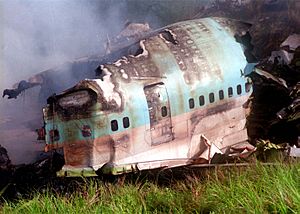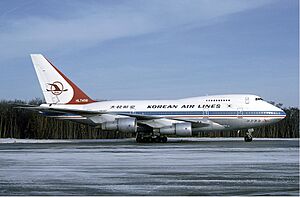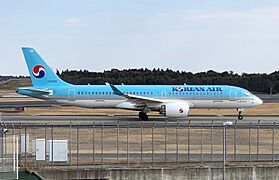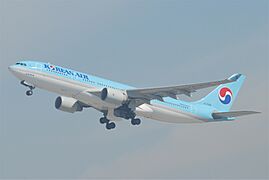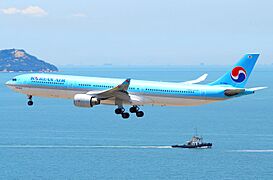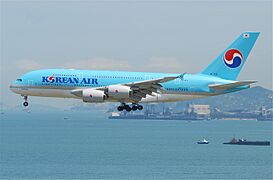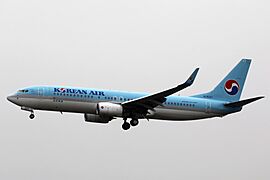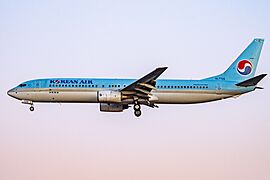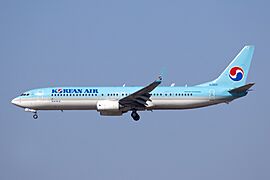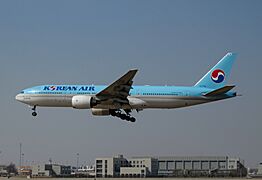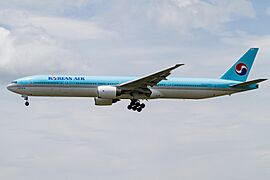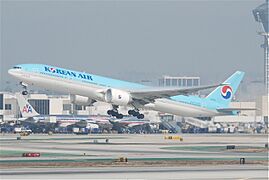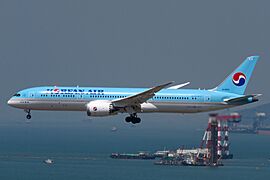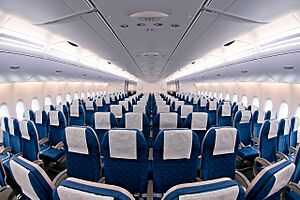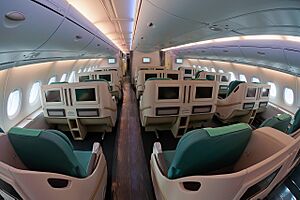Korean Air facts for kids
| Founded | June 1962 (as Korean Air Lines) |
|---|---|
| Commenced operations | March 1, 1969 |
| Hubs |
|
| Focus cities |
|
| Frequent-flyer program | SKYPASS |
| Alliance | |
| Subsidiaries |
|
| Fleet size | 165 |
| Destinations | 108 |
| Parent company | Hanjin Group |
| Headquarters | Seoul, South Korea |
| Key people | Walter Cho (Chairman & CEO) |
| Revenue | |
| Operating income | |
| Net income | |
| Total assets | |
| Employees | 20,000 |
| Korean name | |
| Hangul | |
|---|---|
| Hanja | |
| Revised Romanization | Daehan Hanggong |
| McCune–Reischauer | Taehan Hanggong |
Korean Air Lines Co., Ltd. (KAL; Hangul: 주식회사 대한항공; Hanja: 株式會社 大韓航空; RR: Jusikhoesa Daehan Hanggong), operating as Korean Air, is the flag carrier of South Korea and its largest airline based on fleet size, international destinations, and international flights. It is owned by the Hanjin Group.
The present-day Korean Air traces its history to March 1, 1969, when the Hanjin group acquired government-owned Korean Air Lines, which had operated since June 1962. Korean Air is a founding member of SkyTeam alliance and SkyTeam Cargo. It is one of the 10 airlines ranked 5-star airline, and the top 20 airlines in the world in terms of passengers carried and is also one of the top-ranked international cargo airlines.
Korean Air's international passenger division and related subsidiary cargo division together serve 126 cities in 44 countries. Its domestic division serves 13 destinations. The airline's global headquarters is located in Seoul, South Korea. The airline had approximately 20,540 employees as of December 2014.
The airline was once known as "an industry pariah, notorious for fatal crashes" due to its poor safety record and a large number of incidents and accidents. The airline's reputation has significantly improved in recent decades as it has focused investment on improving its safety record including by hiring consultants from Boeing and Delta Air Lines.
In November 2020, it was announced that Korean Air would seek to merge with domestic rival Asiana Airlines. The proposed merger has yet to be completed amid scrutiny from anti-trust authorities.
Contents
History

Founding
In 1962, government of the Republic of Korea acquired Korean National Airlines, which was founded in 1946, and changed its name to Korean Air Lines to become a state-owned airline. On 1 March 1969, the Hanjin Group acquired the state-owned airline and it is the beginning of Korean Air. Long-haul trans-pacific freight operations were introduced on April 26, 1971, followed by passenger services to Los Angeles International Airport on April 19, 1972.
Expansion
Korean Air operated international flights to destinations such as Hong Kong, Japan, Taiwan, and Los Angeles with Boeing 707s until the introduction of the Boeing 747 in 1973. In that year, the airline introduced Boeing 747s on its trans-Pacific routes and started a European service to Paris, France using the 707 and then McDonnell Douglas DC-10. In 1975, the airline became one of the earliest Asian airlines to operate Airbus aircraft with the purchase of three Airbus A300s, which were put into immediate service on Asian routes. In 1981, Korean Air opened its cargo terminal at Los Angeles International Airport. Since South Korean aircraft were prohibited from flying in the airspace of North Korea and the Soviet Union at the time, the European routes had to be designed eastbound from South Korea, such as Seoul ~ Anchorage ~ Paris.
Change to 'Korean Air'
A blue-top, silver and redesigned livery with a new corporate "Korean Air" logo featuring a stylized Taegeuk design was introduced on March 1, 1984, and the airline's name changed to Korean Air from Korean Air Lines. This livery was introduced on its MD-80s and Boeing 747-300s. It was designed in cooperation between Korean Air and Boeing. In the 1990s, Korean Air became the first airline to use the new McDonnell Douglas MD-11 to supplement its new fleet of Boeing 747-400 aircraft; however, the MD-11 did not meet the airline's performance requirements and they were eventually converted to freighters. Some older 747 aircraft were also converted for freight service. In 1984, Korean Air's head office was in the KAL Building on Namdaemunno, Jung-gu, Seoul.
Checkered safety culture and record
Korean Air was once notorious for its abysmal safety record and high rate of fatal crashes. In 1999, Korea's President Kim Dae-jung described the airline's safety record as "an embarrassment to the nation" and chose Korean Air's smaller rival, Asiana, for a flight to the United States.
Between 1970 and 1999, Korean Air wrote off 16 aircraft due to serious incidents and accidents with the loss of over 700 lives. In the case of Korean Air Flight 801, the National Transportation Safety Board unanimously concluded that the airline's inadequate pilot training contributed to the pilot error that caused the fatal crash.
In 1999, Delta Air Lines suspended its code-sharing relationship with Korean Air explicitly citing its poor safety record following the fatal crash of Korean Air Cargo Flight 6316. It marked the first time safety was explicitly cited as the reason for stopping a major code-sharing alliance by an airline. Other partners including Air Canada and Air France followed suit.
In 2001, the Federal Aviation Administration downgraded South Korea's aviation safety rating and blocked South Korean carriers from expanding into the United States after the country and its carriers failed to improve sufficiently following a warning the previous year. The move was driven by the country's lax oversight of its carriers including Korean Air.
The rating has since been restored as the airline invested billions of dollars to improve safety, upgrade its fleet, install new technology, and overhaul its corporate culture including hiring consultants from Boeing and Delta Air Lines. In 2002, the New York Times noted that Korean Air had been removed from many "shun lists".
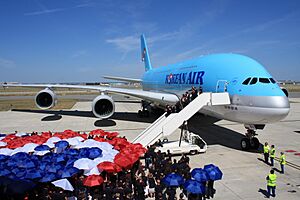
Early 21st century
On 23 June 2000, along with Aeroméxico, Air France and Delta Air Lines, Korean Air founded world's major airline alliance, SkyTeam and SkyTeam Cargo, founded on 28 September 2000.
On 5 June 2007, Korean Air said that it would create a new low-cost carrier called Jin Air in Korea to compete with Korea's KTX high-speed railway network system, which offered cheaper fares and less stringent security procedures compared to air travel. Jin Air started scheduled passenger service on July 17, 2008. Korean Air announced that some of its 737s and A300s would be given to Jin Air.
In mid-2010, a co-marketing deal with games company Blizzard Entertainment sent a 747-400 and a 737-900 taking to the skies wrapped in StarCraft II branding. In August 2010, Korean Air announced heavy second-quarter losses despite record-high revenue. In August 2010, Hanjin Group, the parent of KAL, opened a new cargo terminal at Navoiy International Airport in Uzbekistan, which will become a cargo hub with regular Seoul-Navoi-Milan flights.
In 2013, Korean Air acquired a 44% stake in Czech Airlines. It sold the stake in October 2017. On 1 May 2018, the airline launched a joint venture partnership with Delta Air Lines.
In 2019, Korean Air began playing a safety video with the K-pop group SuperM. It featured the song "Let's go everywhere", which was to be released as a single. The airline also featured the group on a livery sported by a Boeing 777-300ER, with registration HL8010.
In 2023, Korean Air was certified a 5-star Airline by Skytrax, an air transport rating organization.
Nut rage incident
Cho Hyun-Ah, also known as "Heather Cho", is the daughter of then-chairman Cho Yang-ho. She resigned from some of her duties in late 2014 after she ordered a Korean Air jet to return to the gate to allow a flight attendant to be removed from the aircraft. The attendant had served Cho nuts in a bag instead of on a plate. As a result of further fallout, Cho Hyun-Ah was later arrested by Korean authorities for violating South Korea's aviation safety laws.
Proposed merger with Asiana Airlines
In November 2020 during the COVID-19 pandemic, the South Korean Government officially announced that Korean Air will acquire Asiana Airlines. The Ministry of Land, Infrastructure and Transport of the Republic of Korea will integrate subsidiaries Air Busan, Air Seoul and Jin Air to form a combined low-cost carrier which will focus on regional airports in Korea.
In March 2021, KAL announced the merger with Asiana Airlines will be delayed as foreign authorities have not approved the deal. As of 2023, the deal has not been completed as essential countries have approached the deal with skepticism.
Corporate affairs and identity
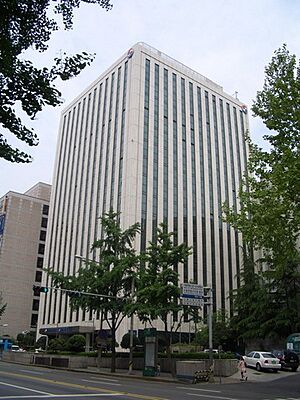
Ownership
Korean Air is owned by Hanjin Group and it is majority controlled by Hanjin KAL Corporation. The owner family of Hanjin Group is still the airline's largest and controlling, shareholder; Walter Cho, its current chairman and CEO, is the third generation of the family to lead the airline. As of 5 June 2020, Hanjin KAL holds 29.27% of Korean Air shares.
Hubs and headquarters
Incheon International Airport Terminal 2 is Korean Air's international hubs.
Korean Air's headquarters (대한항공 빌딩/大韓航空 빌딩) is located in Gonghang-dong, Gangseo-gu in Seoul. The company also maintains a satellite headquarters campus at Incheon. Korean Air also has offices at Gimpo International Airport in Seoul.
Korean Air's other hubs are at Jeju International Airport, Jeju and Gimhae International Airport, Busan. The maintenance facilities are located in Gimhae International Airport. The majority of Korean Air's pilots, ground staff, and flight attendants are based in Seoul and Busan.
Chaebol and nepotism
Korean Air has been cited as one of the examples of the South Korean "chaebol" system, wherein corporate conglomerates, established with government support, overreach diverse branches of industry. For much of the time between the foundation of Korean Air as Korean National Airlines in 1946 and the foundation of Asiana Airlines in 1988, Korean Air was the only airline operating in South Korea.
The process of the sale of Korean National Airlines to Hanjin in 1969 was supported by Park Chung Hee, the South Korean military general president who seized power of the country through a military coup d'état; and the monopoly of the airline was secured for two decades.
After widening the chaebol branches, the subsidiary corporations of Korean Air include marine and overland transportation businesses, hotels, and real estate among others; and the previous branches included heavy industry, passenger transportation, construction, and a stockbroking business. The nature of the South Korean chaebol system involves nepotism. A series of incidents involving Korean Air in the 2000s have "revealed an ugly side of the culture within chaebols, South Korea's giant family-run conglomerates".
Hotel ownership
Korean Air owns five hotels: two KAL hotels on Jeju island, the Hyatt in Incheon; Waikiki Resort in Hawaii, and a hotel/office building called the Wilshire Grand Tower in Los Angeles. This building in downtown Los Angeles houses the largest InterContinental Hotel in the Americas in what is the tallest building in Los Angeles.
Korean Air Aerospace Division
Korean Air is also involved in aerospace research and manufacturing. The division, known as the Korean Air Aerospace Division (KAL-ASD), has manufactured licensed versions of the MD Helicopters MD 500 and Sikorsky UH-60 Black Hawk helicopters, as well as the Northrop F-5E/F Tiger II fighter aircraft, the aft fuselage and wings for the KF-16 fighter aircraft manufactured by Korean Aerospace Industries and parts for various commercial aircraft including the Boeing 737, Boeing 747, Boeing 777 and Boeing 787 Dreamliner; and the Airbus A330 and Airbus A380. In 1991, the division designed and flew the Korean Air Chang-Gong 91 light aircraft. KAA also provides aircraft maintenance support for the United States Department of Defense in Asia and maintains a research division with focuses on launch vehicles, satellites, commercial aircraft, military aircraft, helicopters, and simulation systems.
In October 2012, a development deal between Bombardier Aerospace and a government-led South Korean consortium was announced, aiming to develop a 90-seat turboprop regional airliner, targeting a 2019 launch date. The consortium would have included Korea Aerospace Industries and Korean Air. While this plan did not come to fruition, in 2019, Korean Aerospace Industries nevertheless decided to conduct a two-year study to assess the feasibility of taking the lead on building a turboprop airliner.
Destinations
Korean Air has codeshare agreements with the following airlines:
- Aeroflot (suspended)
- Aerolíneas Argentinas
- Aeroméxico
- Air Europa
- Air France
- Air Tahiti Nui
- Alaska Airlines
- Aurora
- China Airlines
- China Eastern Airlines
- China Southern Airlines
- Czech Airlines
- Delta Air Lines (Joint Venture Partners)
- Emirates
- Etihad Airways
- Garuda Indonesia
- Gol Linhas Aéreas Inteligentes
- Hainan Airlines
- Hawaiian Airlines
- ITA Airways
- Japan Airlines
- Jin Air (Subsidiary)
- Kenya Airways
- KLM
- LATAM Brasil
- LATAM Chile
- LATAM Perú
- Malaysia Airlines
- MIAT Mongolian Airlines
- Myanmar Airways International
- Rossiya Airlines
- Royal Brunei Airlines
- Saudia
- Shanghai Airlines
- SriLankan Airlines
- Uzbekistan Airways
- Vietnam Airlines
- Virgin Atlantic
- WestJet
- XiamenAir
Interline agreements
Korean Air has interline agreements with the following airlines:
Korean Air is also an airline partner of Skywards, the frequent-flyer program for Emirates. Skywards members can earn miles for flying Korean Air and can redeem miles for free flights.
Fleet
Current fleet
As of May 2024[update], Korean Air operates the following aircraft:
| Aircraft | In service | Orders | Passengers | Notes | |||
|---|---|---|---|---|---|---|---|
| F | P | E | Total | ||||
| Airbus A220-300 | 10 | — | — | — | 140 | 140 | Order with 10 options and 10 purchase rights. |
| Airbus A321neo | 9 | 41 | — | 8 | 174 | 182 | Order with 20 options. Delivery starts from October 2022. |
| Airbus A330-200 | 5 | — | — | 30 | 188 | 218 | To be leased to T'way Air. |
| Airbus A330-300 | 21 | — | — | 24 | 248 | 272 | |
| 24 | 252 | 276 | |||||
| 24 | 260 | 284 | |||||
| Airbus A350-900 | — | 6 | TBA | ||||
| Airbus A350-1000 | — | 27 | TBA | ||||
| Airbus A380-800 | 9 | — | 12 | 94 | 301 | 407 | |
| Boeing 737-800 | 2 | — | — | 12 | 126 | 138 | |
| Boeing 737-900 | 9 | — | — | 8 | 180 | 188 | |
| Boeing 737-900ER | 6 | — | — | 8 | 165 | 173 | |
| Boeing 737 MAX 8 | 5 | 25 | — | 8 | 138 | 146 | Order with 20 options. Delivery starts from February 2022. |
| Boeing 747-8I | 9 | — | 6 | 48 | 314 | 368 | Includes HL7644, the last passenger 747 ever built. 5 to be sold to Sierra Nevada Corporation in 2025, likely for conversion to the USAF's SAOC. |
| 1 | VIP | Leased to Republic of Korea Air Force for VIP transport | |||||
| Boeing 777-200ER | 8 | — | 8 | 28 | 225 | 261 | |
| Boeing 777-300 | 4 | — | — | 41 | 297 | 338 | |
| Boeing 777-300ER | 25 | — | 8 | 42 | 227 | 277 | |
| 8 | 56 | 227 | 291 | ||||
| Boeing 787-9 | 13 | 7 | — | 24 | 245 | 269 | Order with 10 options. Order was converted from Boeing 787-8. |
| 254 | 278 | ||||||
| Boeing 787-10 | — | 20 | TBA | ||||
| Korean Air Cargo fleet | |||||||
| Boeing 747-400ERF | 4 | — | Cargo | ||||
| Boeing 747-8F | 7 | — | Cargo | ||||
| Boeing 777F | 12 | — | Cargo | ||||
| Korean Air Business Jet fleet | |||||||
| AgustaWestland AW139 | 4 | — | 8–14 | ||||
| Boeing 737-700/BBJ1 | 1 | — | 16–26 | ||||
| Boeing 787-8/BBJ | 1 | — | 39 | ||||
| Bombardier Global Express XRS | 1 | — | 13 | ||||
| Gulfstream G650ER | 1 | — | 13 | ||||
| Sikorsky S-76C+ | 1 | — | 5–6 | ||||
| Total | 165 | 126 | |||||
Fleet development
At the Association of Asia Pacific Airlines Assembly in 2018, Korean Air announced that it was considering a new large widebody aircraft order to replace older Airbus A330, Boeing 747-400, Boeing 777-200ER and Boeing 777-300. Types under consideration for replacement of older widebody aircraft in the fleet include the Boeing 777X and Airbus A350 XWB. At the International Air Transport Association Annual General Meeting (IATA AGM) in Seoul, Chairman Walter Cho said Korean Air's widebody order is imminent and it is considering an extra order of Airbus A220 Family including developing version, Airbus A220-500.
In 2022, Korean Air was considering ordering a new freighter to continue the support cargo demand worldwide. Chairman of Korean Air Walter Cho said KAL is considering 2 options and looking at both.
Gallery
- Korean Air current fleet
Retired fleet
Korean Air has operated the following aircraft:
| Aircraft | Total | Introduced | Retired | Replacement | Notes |
|---|---|---|---|---|---|
| Airbus A300B4-2C | 8 | 1975 | 1997 | Airbus A330 | |
| Airbus A300B4-200F | 2 | 1986 | 2000 | None | |
| Airbus A300-600R | 27 | 1987 | 2012 | Airbus A330 | |
| 2 | Converted into freighters and transferred to Korean Air Cargo | ||||
| 1 | 1994 | None | Crashed as flight KE2033 | ||
| Airbus A330-200 | 3 | 1997 | 2023 | Boeing 787 Dreamliner | |
| Airbus A330-300 | 1 | 1998 | 2022 | None | Written off as flight KE631 |
| Airbus A380-800 | 1 | 2011 | 2024 | Airbus A350-1000 | |
| Boeing 707-320B | 4 | 1971 | 1989 | Boeing 747-200B | |
| 1 | 1978 | None | Shot down as flight KE902 | ||
| Boeing 707-320C | 7 | 1971 | 1989 | Boeing 747-200B | |
| 1 | 1987 | None | Destroyed as flight KE858 | ||
| Boeing 720 | 2 | 1969 | 1976 | Boeing 747-200B | |
| Boeing 727-100 | 5 | 1972 | 1985 | McDonnell Douglas MD-80 | |
| Boeing 727-200 | 12 | 1980 | 1996 | McDonnell Douglas MD-80 | |
| Boeing 737-700/BBJ1 | 1 | 2008 | 2018 | None | |
| Boeing 737-800 | 3 | 2007 | 2021 | Airbus A220-300 | |
| 22 | 2000 | 2022 | Transferred to subsidiary Jin Air. | ||
| Boeing 737-900 | 4 | 2001 | 2023 | None | |
| 3 | Transferred to subsidiary Jin Air. | ||||
| Boeing 747-200B | 9 | 1973 | 1998 | Boeing 747-400 | |
| 2 | Converted into freighters and transferred to Korean Air Cargo | ||||
| 1 | 1983 | None | Shot down as flight KE007 | ||
| 1 | 1980 | Destroyed as flight KE015 | |||
| Boeing 747-200C | 2 | 1973 | 2000 | None | |
| Boeing 747-200F | 7 | 1978 | 2006 | Boeing 747-400F | |
| 1 | 1999 | None | Crashed as flight KE8509 | ||
| Boeing 747-200SF | 2 | 1991 | 2002 | Boeing 747-400F | |
| Boeing 747-300 | 1 | 1984 | 2006 | Boeing 747-400 | |
| 1 | 1997 | None | Crashed as flight KE801 | ||
| Boeing 747-300M | 1 | 1988 | 2001 | Boeing 747-400M | Converted into freighters and transferred to Korean Air Cargo |
| Boeing 747-300SF | 1 | 2001 | 2006 | Boeing 747-400F | |
| Boeing 747-400 | 17 | 1989 | 2020 | Boeing 747-8I Boeing 777-300ER |
|
| 8 | 2007 | Converted into freighters and transferred to Korean Air Cargo | |||
| 1 | 1998 | None | Crashed as flight KE8702 | ||
| 1 | 2001 | 2010 | Leased to Republic of Korea Air Force for VIP transport until 2021 | ||
| Boeing 747-400BCF | 8 | 2007 | 2014 | Boeing 777F | |
| Boeing 747-400ERF | 4 | 2003 | 2017 | Boeing 777F | |
| Boeing 747-400F | 10 | 1996 | 2018 | Boeing 777F | |
| Boeing 747-400M | 1 | 1990 | 2010 | Boeing 777-300ER | |
| Boeing 747SP | 2 | 1981 | 1998 | Boeing 777-200ER | |
| Boeing 777-200ER | 6 | 1997 | 2023 | Boeing 787 Dreamliner | |
| 4 | 2005 | 2016 | Transferred to subsidiary Jin Air. | ||
| Boeing 777-300ER | 1 | 2009 | 2021 | None | |
| Bombardier Global Express XRS | 2 | 2011 | 2017 | None | |
| CASA C-212 | 1 | 1980 | 2000 | None | |
| Douglas DC-3 | 2 | 1950 | 1970 | Unknown | |
| Douglas DC-4 | 2 | 1953 | 1969 | Unknown | |
| Douglas DC-8-60 | 6 | 1972 | 1976 | Boeing 707 | |
| Eurocopter EC135-P2+ | 5 | 2011 | 2018 | None | |
| Eurocopter EC155-B1 | 2 | 2004 | 2018 | None | |
| Fairchild-Hiller FH-227 | 2 | 1967 | 1970 | NAMC YS-11A-200 | |
| Fokker F27-200 | 3 | 1963 | 1980 | Fokker F27-500 | |
| Fokker F27-500 | 3 | 1969 | 1991 | Fokker F28-4000 | |
| Fokker F27-600 | 1 | 1982 | 1986 | Fokker F28-4000 | |
| Fokker F28-4000 | 3 | 1984 | 1993 | Fokker 100 | |
| 1 | 1989 | None | Crashed as flight KE175 | ||
| Fokker 100 | 12 | 1992 | 2004 | Boeing 737-800 | |
| Gulfstream IV | 1 | 1994 | 2012 | Boeing BBJ1 | |
| Lockheed L-749A Constellation | Unknown | Unknown | Unknown | None | |
| Lockheed L-1049H Super Constellation | 2 | 1966 | 1967 | None | |
| McDonnell Douglas DC-9-32 | 2 | 1967 | 1972 | Boeing 727 | |
| McDonnell Douglas DC-10-30 | 4 | 1975 | 1996 | McDonnell Douglas MD-11 | |
| 1 | 1989 | None | Crashed as flight KE803 | ||
| McDonnell Douglas DC-10-30CF | 1 | 1978 | 1983 | None | |
| McDonnell Douglas MD-11 | 5 | 1991 | 1995 | Airbus A330 Boeing 777 |
Converted into freighters and transferred to Korean Air Cargo |
| McDonnell Douglas MD-11F | 4 | 1995 | 2005 | Boeing 747-400BCF | |
| 1 | 1999 | None | Crashed as flight KE6316 | ||
| McDonnell Douglas MD-82 | 9 | 1993 | 2001 | Boeing 737 Next Generation | |
| McDonnell Douglas MD-83 | 7 | 1994 | 2001 | Boeing 737 Next Generation | |
| 1 | 1999 | None | Crashed as flight KE1533 | ||
| NAMC YS-11A-200 | 6 | 1968 | 1976 | Boeing 727 | |
| 1 | 1969 | None | Hijacked and captured by North Korea |
Cabins
Korean Air currently offers three types of first class, four types of business (Prestige) class, and standard economy class. Korean Air operates First Class on all Boeing 747-8I and parts of its 777-300ER, Airbus A380-800, Boeing 777-200ER, and -300ER fleets. Some seats are equipped as suites with doors. The airline markets Business Class as "Prestige Class" with some aircraft equipped with suites. The airline announced its introduction of Premium Economy in 2017. The first aircraft equipped with premium economy marketed as "Economy Plus" was CS300 (Airbus A220-300). The product was eliminated in 2019 due to discordance of service and profit loss. The airline also offers Economy Class.
Incidents and accidents
In the late 1990s, Korean Air was "an industry pariah, notorious for fatal crashes" due to its extremely poor safety record and being one of the world's most dangerous airlines. Safety has seemingly improved since as the airline made concerted efforts to improve standards in the early 21st century. In 2001, the Federal Aviation Administration upgraded Korea's air-safety rating while Korean Air passed an International Air Transport Association audit in 2005.
Between 1970 and 1999, many fatal incidents occurred. Since 1970, 17 Korean Air aircraft have been written off in serious incidents and accidents with the loss of 700 lives. Two Korean Air aircraft were shot down by the Soviet Union, one operating as Korean Air Lines Flight 902 and the other as Korean Air Lines Flight 007.
Korean Air's deadliest incident was Flight 007 which was shot down by the Soviet Union on September 1, 1983. All 269 people on board were killed, including a sitting U.S. Congressman, Larry McDonald.
The last fatal passenger accident was the Korean Air Flight 801 crash in 1997, which killed 229 people of the 254 people aboard including Shin Ki-ha, a South Korean parliamentarian. The National Transportation Safety Board concluded that poor communication between the flight crew as the probable cause for the air crash, along with the captain's poor decision-making on the non-precision approach.
The last crew fatalities were in the crash of Korean Air Cargo Flight 8509 in 1999 due to instrument malfunction and pilot error.
The last aircraft write-off occurred in 2022, when Korean Air Flight 631 overran the runway at Cebu, Philippines while attempting to land under poor weather conditions.
In a 2023 "landmark decision", the state-affiliated Korea Worker's Compensation and Welfare Service ruled that the cancer death of a flight attendant was akin to an industrial accident. The plaintiff had flown for 25 years on routes to Europe and America, which exposed workers to more cosmic radiation because Earth's magnetic field is weaker over the North Pole. Korean Air said it monitors and limits individual radiation exposure to less than 6mSv a year. The plaintiff's attorney contends that the company uses an old measuring method. The ruling panel said that the method employed by Korean Air could have downplayed the extent of radiation exposure and that the flight attendant could have been exposed to over 100mSv of radiation.
See also
 In Spanish: Korean Air para niños
In Spanish: Korean Air para niños
- List of airlines of South Korea
- List of airports in South Korea
- List of companies of South Korea
- Transport in South Korea


